Three big dental groups want managers of the District of Columbia health insurance exchange to make room for stand-alone children’s dental plans.
Reps for Delta Dental, MetLife and Guardian Life Insurance Co. of America say creating a market for stand-alone dental coverage for children would help families buy better coverage.
Consumer groups question whether stand-alone dental coverage will be a viable product.
Carriers say building children’s dental benefits into all exchange plans is easier and better.
Members of the board of the D.C. Health Benefit Exchange Authority – the body that oversees the DC Health Link exchange – are preparing to talk about 2015 dental plan options at a meeting Wednesday.
The Patient Protection and Affordable Care Act require exchange plans to cover a package of essential health benefits that includes pediatric dental benefits.
The U.S. Department of Health and Human Services says an exchange can meet the requirement by offering stand-alone dental plans for children.
The District of Columbia requires carriers to sell all new individual major medical coverage through its exchange. The four carriers offering individual qualified health plans through the exchange this year all built children’s dental benefits into their plans.
D.C. regulators decided that, because all of the individual plans included children’s dental coverage, consumers had no need for stand-alone dental plans. Regulators refused to approve the sale of any stand-alone children’s dental plans.
Dental carriers can still sell stand-alone dental coverage for adults and families, but, because of the way the D.C. market is set up, they can no longer sell any stand-alone children’s dental plans, either inside or outside the exchange.
Major medical carriers say one advantage is that all children in the district now have dental coverage.
At some state exchanges, only a minority of children receive dental.
But reps say the embedded dental benefits can expose families to huge, unexpected dental bills.
Families with a $4,000 plan deductible might have to meet the full $4,000 deductible before the plan will pay to fill a child’s cavity.
Moreover, because the plan out-of-pocket maximum applies to both medical and dental expenses, a family with a $30,000 out-of-pocket maximum might have to spend as much as $30,000 on dental care for a child before the out-of-pocket maximum would kick in and the plan would cover the full cost.
A D.C. exchange dental plan working group has proposed limiting the deductible for in-network children’s dental services to $50 for individuals and $100 for families.
The working group has talked about the possibility of letting plan issuers continue to build children’s dental benefits into all of their exchange plans, if they want to do that, and asking D.C. insurance regulators to let dental issuers sell stand-alone dental coverage through the exchange.
“This would permit consumers to select a stand-alone dental plan if they thought it was a superior option, even if it duplicates benefits in their main [plan],” working group members say in a report on their discussions.
.
See also:
© 2025 ALM Global, LLC, All Rights Reserved. Request academic re-use from www.copyright.com. All other uses, submit a request to [email protected]. For more information visit Asset & Logo Licensing.







